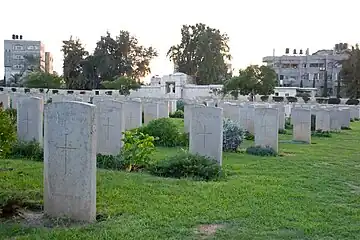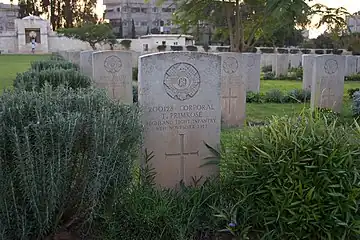

The Commonwealth Gaza War Cemetery, often referred to as the British War Cemetery, is a cemetery administered by the Commonwealth War Graves Commission on the Salah al-Din Road in Gaza City's Tuffah district.[1]
Graves

The majority of burials at the cemetery are of Allied soldiers who lost their lives in World War I, principally in the First, Second and Third Battles of Gaza. Some 3,217 British and Commonwealth servicemen are buried in the cemetery; nearly 800 of the graves lack identification, and are inscribed "A Soldier of the Great War, known unto God".[2] 234 graves of non-Commonwealth soldiers are also present in the cemetery.[2] A further 210 Commonwealth soldiers were interred in the cemetery following their death in World War II; the post-war period saw 30 more burials.[2]
The majority of the graves (3082 of 3691) are British, but there are also the graves of 263 Australians, 50 Indians, 23 New Zealanders, 23 Canadians, 36 Poles, and 184 Ottoman-era Turkish graves, plus small numbers of South African, Greek, Egyptian, German, French and Yugoslavian graves.[3]
History
The cemetery was completed by 1920, and has been tended by three men from the same family ever since.[4] For 45 years, the cemetery was tended by Ibrahim Jeradeh, who was employed by the Commonwealth War Graves Commission.[4] Jeradeh's father was the cemetery's initial head gardener, and he himself was succeeded by his son.[4] Jeradeh was awarded an MBE in "grateful recognition of outstanding contribution to the Commonwealth War Graves Commission".[4][3] The MBE's accompanying certificate was signed by the Duke of Kent.[4]
In 2004, 33 headstones were vandalised in the cemetery, allegedly in retaliation for the Abu Ghraib prisoner abuse scandal.[5]
The cemetery was struck by Israeli shells on two occasions in the 2010s.[4] An Israeli airstrike in 2006 led to £90,000 in compensation being paid to the Commonwealth War Graves Commission; in addition some 350 headstones needed repair following damage from Israeli shells in Operation Cast Lead in 2008–2009.[4] The cemetery is reported to have been damaged again in the Israel–Hamas war of 2023.[6]
Amongst the graves is that of Stanley Boughey (1896–1917), who received the Victoria Cross for action against the Ottoman Army at El Burff, Palestine.[7] British journalist and writer Mark Urban (whose great-uncle is buried in the cemetery) visited it in 2009 for BBC 2's Newsnight, and wrote an article for The Observer detailing his experiences there.[8]
Gallery
 Graves of unidentified soldiers, "Known unto God"
Graves of unidentified soldiers, "Known unto God" View of the cemetery from its south-west end
View of the cemetery from its south-west end Grave of Corporal T. Primrose, Highland Light Infantry
Grave of Corporal T. Primrose, Highland Light Infantry
References
- ↑ Gaza War Cemetery at the Commonwealth War Graves Commission
- 1 2 3 Harriet Sherwood (18 August 2013). "Tending the war graves of Gaza City". The Guardian. Retrieved 1 August 2014.
- 1 2 Wright, Tony (13 October 2023). "This is where war always ends, said the gardener of Gaza's graveyard". The Sydney Morning Herald. Retrieved 26 November 2023.
- 1 2 3 4 5 6 7 Harriet Sherwood (18 August 2013). "Tending the war graves of Gaza City". The Guardian. Retrieved 1 August 2014.
- ↑ Lynfield, Ben (11 May 2004). "Palestinians vandalise UK war graves". The Scotsman. Archived from the original on 24 April 2005. Retrieved 15 September 2006.
- ↑ "Damage to Gaza War Cemetery shows challenge of caring for monuments in conflict zones". The Canadian Press. 10 November 2023. Retrieved 12 November 2023.
- ↑ Boughey, Stanley Henry Parry, Commonwealth War Graves Commission
- ↑ Urban, Mark (22 February 2009). "Battle still rages where my brave great-uncle fell in Gaza back in 1917". The Observer. Retrieved 1 August 2014.
Further reading
- Sheehan, Sean (2000). Israel Handbook: With the Palestinian Authority Areas. Footprint Travel Guides. ISBN 978-1-900949-48-4.